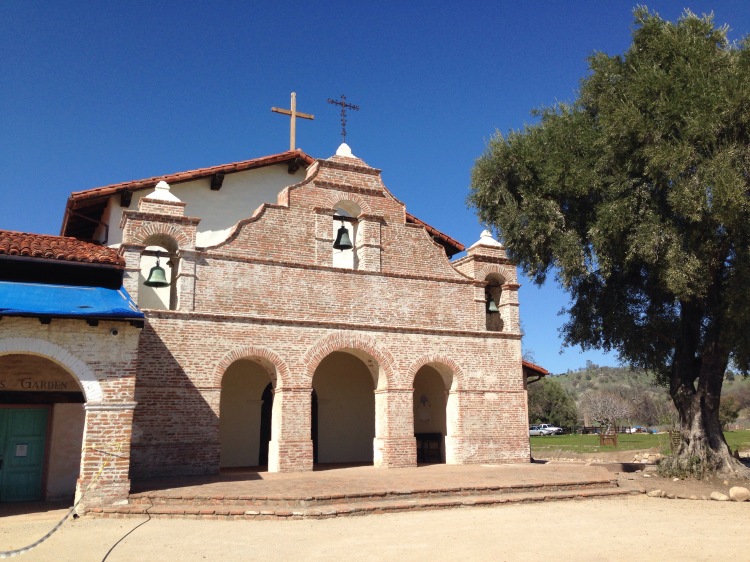 I slept in the big echoing portico of brick and plaster. It took awhile for all my limbs to straighten out, but I fell asleep around midnight listening to the coyotes howling and chattering off in the hills. Unbeknownst to me, a flock of turkeys were roosting in the giant olive tree out front, planted here in 1836, so I awoke at sunrise to the flapping of great wings, and gobbling as they all descended to the patio only a few feet from where I lay.
I slept in the big echoing portico of brick and plaster. It took awhile for all my limbs to straighten out, but I fell asleep around midnight listening to the coyotes howling and chattering off in the hills. Unbeknownst to me, a flock of turkeys were roosting in the giant olive tree out front, planted here in 1836, so I awoke at sunrise to the flapping of great wings, and gobbling as they all descended to the patio only a few feet from where I lay.
The mission is currently being retrofitted with steel braces as a safety measure against earthquakes, a $15 million project I am told, so the arrival of the sun and the turkeys was accompanied by several trucks of native and Mexican construction workers. They set about drilling and hammering while I groaned to my feet and dug out some breakfast. Jody had given me two bags of Dave’s Killer Bread, the seeds and nuts kind, which I love. I figure it will be the first to spoil, so I’ll take a rest from granola while the fresh stuff lasts.
I had not announced my presence yet to the proprietors, but the lady from the office soon came out with one of the construction workers to ascertain what this homeless vagrant was doing sleeping on their front doorstep. When she heard I was a pilgrim, she was all smiles and welcome. She made me coffee, opened the church early for me, and burned some incense. It really makes a difference having incense; it reminds me that the building I am entering is not just a building, is not just a church as the common notion goes, but is the portal between the church on earth and the church eternal, the gates of heaven.
 The church is fairly big, as big as any I have seen yet, and is entered from the courtyard through a side door.
The church is fairly big, as big as any I have seen yet, and is entered from the courtyard through a side door.
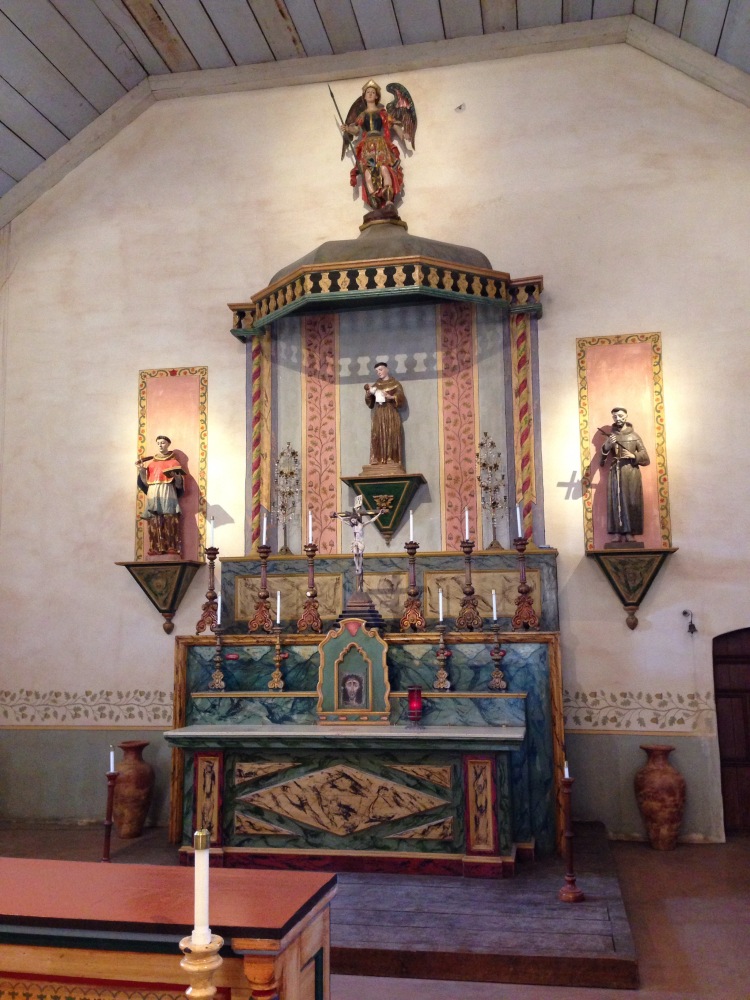 Besides the altar statuary, there are only two paintings on the walls.
Besides the altar statuary, there are only two paintings on the walls.
 One is the last judgement.
One is the last judgement.
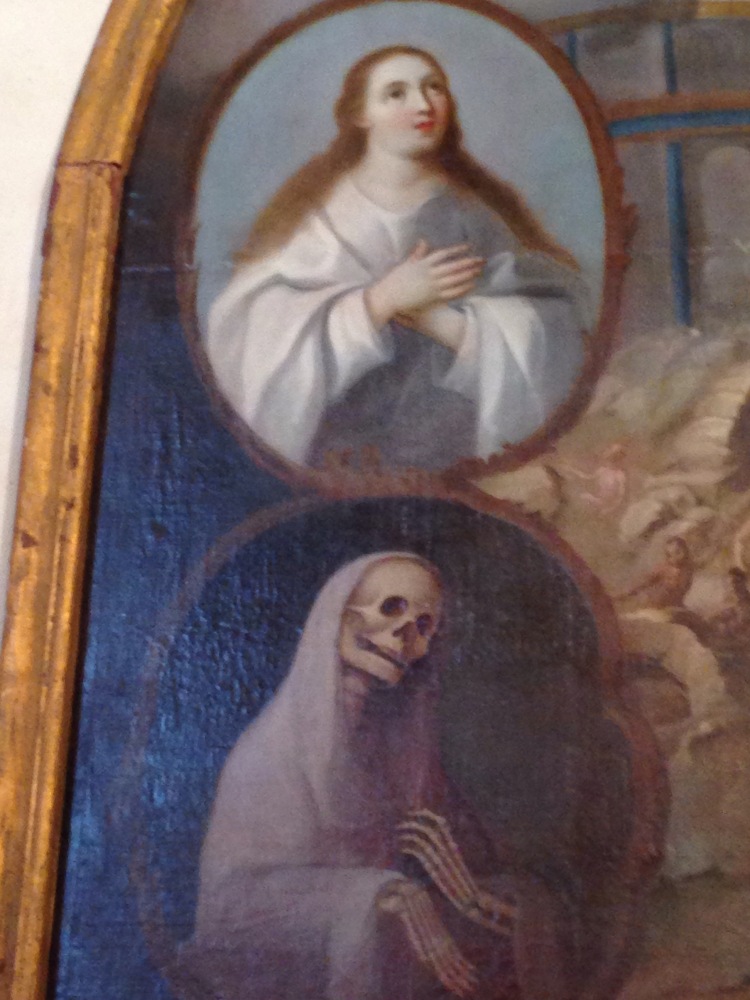
And the other I couldn’t readily identify. Maybe depicting Hell, or Mary interceding for the souls in purgatory?
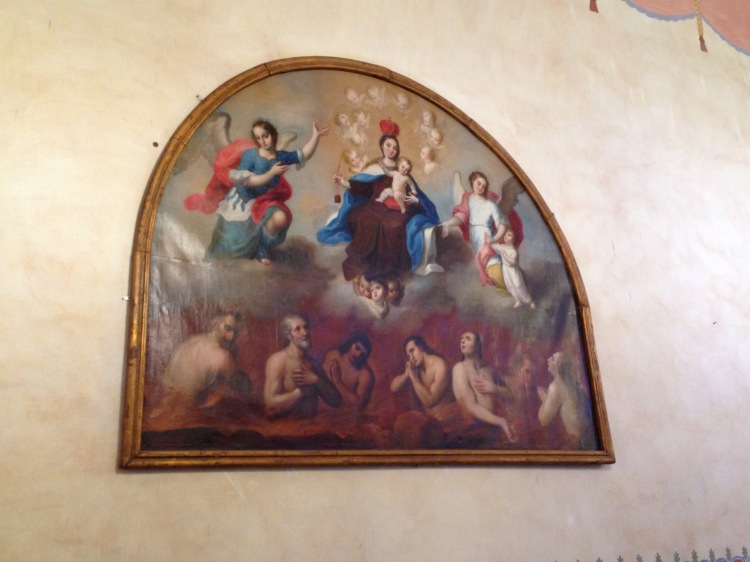 The timing of my visit to this mission was different than the others: I got to go right in almost first thing in the morning. It was a therapeutic and restabilizing way to begin again after yesterday’s physical and emotional roller coaster. I took off my shoes and paced up and down the sandy floor of the big empty church, smelling the incense, saying my rosary, and looking at the images. A girl came in before I was done and started vacuuming, but for some reason it didn’t really bother me.
The timing of my visit to this mission was different than the others: I got to go right in almost first thing in the morning. It was a therapeutic and restabilizing way to begin again after yesterday’s physical and emotional roller coaster. I took off my shoes and paced up and down the sandy floor of the big empty church, smelling the incense, saying my rosary, and looking at the images. A girl came in before I was done and started vacuuming, but for some reason it didn’t really bother me.
 The mission was founded by St. Junipero Serra in 1771, and was the first irrigation system in California. At its height, it housed over 1300 people, and had thousands of cattle and horses. After the Secularization act of 1833, the mission, like so many others, was neglected and started to fall apart. William Randolph Hearst owned and ranched all the the land which is now Fort Hunter-Ligget, including the dilapidated mission. His hacienda still sits only a short distance from the mission, on a hilltop on the edge of Fort Hunter-Liogget. In 1948 the Hearst family helped to fund the restoration of the mission. It is now a small parish of about 40 families, a retreat center, and the fort’s Catholic Chapel.
The mission was founded by St. Junipero Serra in 1771, and was the first irrigation system in California. At its height, it housed over 1300 people, and had thousands of cattle and horses. After the Secularization act of 1833, the mission, like so many others, was neglected and started to fall apart. William Randolph Hearst owned and ranched all the the land which is now Fort Hunter-Ligget, including the dilapidated mission. His hacienda still sits only a short distance from the mission, on a hilltop on the edge of Fort Hunter-Liogget. In 1948 the Hearst family helped to fund the restoration of the mission. It is now a small parish of about 40 families, a retreat center, and the fort’s Catholic Chapel.
I went to the office to thank the lady working there. Her name was Joan, she was a parishioner, a mother of five, and the religious education director. We talked about various things: teaching the faith, history, fundraising for the construction project. She asked if I had seen a big black cat around, I said he had greeted me when I arrived, but didn’t stick around long.
“That cat is a miracle cat,” she said. “When he was still a kitten, one of the soldiers from the base died in an accident, and we were holding a rosary service with his family. I wouldn’t even bother telling you this if I didn’t have 200 witnesses, but that cat walked right up the center aisle, into the sachristy, brought out a rosary and put it on the mother’s lap. That’s why we named him Rosario”
That wasn’t the end of it.
“A man from the base came here late one night to say goodbye to God before he committed suicide. He later told us that Rosario came and sat with him for hours, just sat with him and comforted him. By the time morning came, the man had decided to give life another chance. Another time, some visitors were standing around looking at an old facade. Rosario got their attention and led them just around the corner. Once around the corner, the old facade collapsed without warning. It would have killed them.”
I asked her what it was like having a retreat center on the grounds.
“It’s mostly confirmation retreats for teenagers, but we get all kinds. Some of these kids are not here because they have any great love or interest, but just because their parents tell them to come. I tell those kids ‘having Catholic parents doesn’t cut it, you have to have your own relationship with God. God doesn’t have grandchildren, only children.'”
As I was packing my bag out in the sunny yard, a thin, comfortably dressed man with greying hair approached me and asked in a nervous Detroit accent if I was “camping or something.” I briefly explained myself (I’m getting pretty good at this), and asked him for his story.
John is from the Detroit suburbs. He moved to fort Hunter Ligget with his wife and two boys to take a job as an environmental engineer. While he lived here, the mission was his parish church, here his sons had their first communion, and here his wife began cheating on him with the soldiers on base. She divorced him two years ago, took his sons away, (“ripped them from my flesh” we’re his words, and turned him into a wallet to subsidize his now distant and unavailable children. John was left with $600 a month to live on after child support, and has subsequently lost his job. He has been living in his car for the past six months, barely hanging on to his sanity, seriously questioning his self worth and identity, and gradually slipping into dispair. By a tragic coincidence, the mission portico bears a sign which commemorates the first marriage in California, on this spot in 1773.


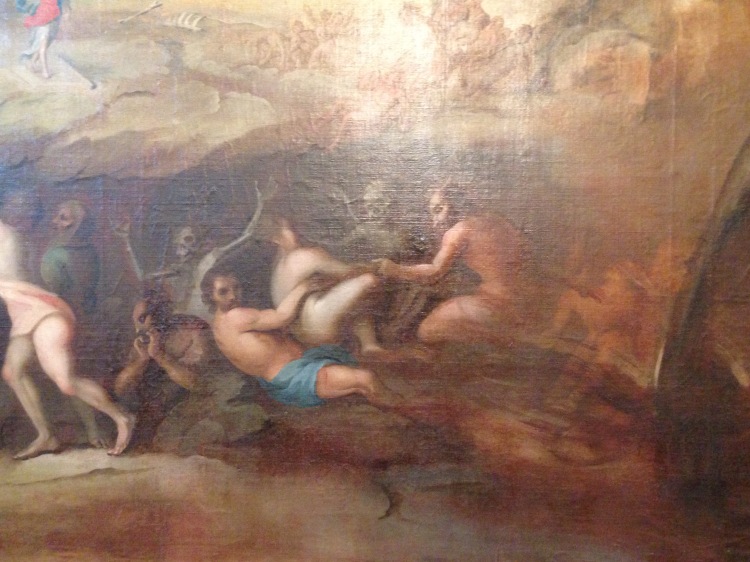

May God bless you on your pilgrimage and beyond, Paul Roundtree.
I thought of you, and prayed for you, during this evening’s, Friday, 02/26, Stations of the Cross.
I considered our Lord struggling to rise, thrice, having fallen beneath the heavy burden of the Cross. And I considered you, tempted to discouragement, even abandonment of your pilgrimage, yet vowing to simply take one more step. Thank you for your example of perseverance.
I considered our Lord stripped naked before his Crucifixion. And I considered you, stripped to the bare belongings of your backpack while on your journey. Thank you for your example away from the lures of the world.
Peace in Christ to you,
John